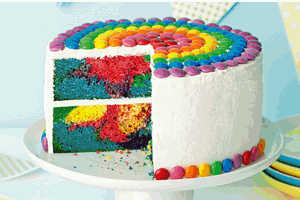- paper chromatography

Cooks use food dyes for decorating cakes and colouring confectionery.
These dyes are sometimes pure substances or they can be a mixture of different substances. Not all food dyes are allowed for use in food and some are banned. Identifying these banned dyes is very important.
We can separate out the colours of a particular food dye by using a process called paper chromatography. This process separates the particles of a particular dye according to their size. Water carries the dye particles up a strip of paper, the heavier particles are harder to transport so they are carried a shorter distance up the paper than smaller particles.
This process involves placing a spot of dye on a paper strip and allowing water to move up the paper carrying the dye particles with it. This is shown on the right.
As you can see in the time lapse animation on the right, some dyes are made of more than one particular substance while others are pure. Dyes that consist of more than one substance are called mixtures, while the dyes that have only one type of particle are known as pure substances. You can see that dye A, C and D are pure substances, whilest dye B is a mixture of two different dye particles of blue and red colour.
This procedure is known as paper chromatography and we can use it to separate the different components of each dye and identify if the food dye is a mixture or a pure substance and even identify the particular components.
